Equestrian Rules
Valid through 2025
Special Olympics New Hampshire has created this set of rules based on the rules outlined by Special Olympics International as well as the International Equestrian Federation (FEI) which is the international governing body for Equestrian
These rules shall be used to govern all Special Olympics New Hampshire Equestrian competition through the end of 2025 when we next review these rules.
Events Offered
- Showmanship
- Equitation
- Dressage
- Pole bending
- Trail Class
- Carriage Driving
- Prix Caprilli
- Jumping
Registration
- All riders must show proof of a negative Coggins Test for their horse within the last 12 months.
- All coaches must submit a level and category for each of their riders, as well as the name of the horse.
- Levels:
- Riders may enter any or all events from their division but may not cross enter division levels.
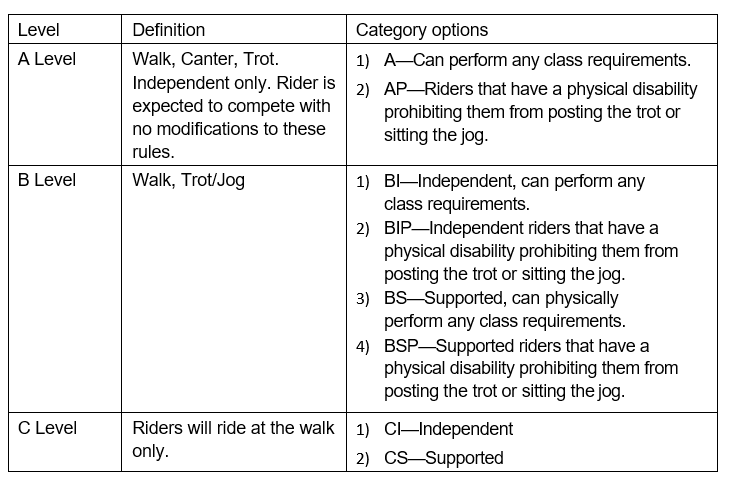
- Categories

- Riders may enter any or all events within their level and category.
Divisioning
- Divisions will be separated by level and category and will accommodate horse sharing.
- Riders are assigned to a division level (A, AP, BS, BSP, BI, BIP, CS, CI) according to their ability to negotiate safely any movements required in the event by their coach prior to the competition.
Equipment
- Local Programs are responsible for bringing their own horses and equipment.
- Attire: Athletes can wear either English or Western riding attire.
- English attire includes dark colored hunt coat or blazer, white or light-colored shirt, light colored riding pants, tall boots or paddock boots, and riding gloves.
- Western attire includes western style shirt, khaki pants, boots, or cowboy boots.
- All riders must wear heeled boots. Riders who must wear other footwear, as the result of a physical disability, must have documentation by a physician stating the need for alternate footwear, submitted during registration. In this case, safety stirrups are obligatory. English tack style riders must use Peacock safety stirrups, S-shaped stirrups, or Devonshire boots.
- Helmets: All riders must wear protective SEI-ASTM or BHS approved helmets with full chin harness which must be fastened at all times when the riders are on or working around horses.
- Competitors must wear their assigned number prominently displayed on their backs during competition, practice at the competition and while in the competition “holding area” (stage).
- During practice, athletes must adhere to the helmet, boots, and long pants rule, but may wear short-sleeved shirts without riding coats.
- Saddles must fit the horse.
- Halters are required for all supported classes. A lead line must be attached to the halter and not to the bridle. The halter may be over or under the bridle as long as it doesn’t interfere with the use of the bit or the reins. Riders may use adaptive equipment without penalty. (Note: Riders may in no way be attached to the horse or saddle)
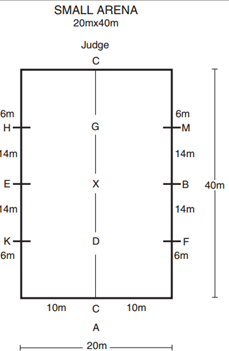
Competition
SET UP: COURSE LAYOUT
- The arena should be on as level a ground as possible and should measure 40 meters by 20 meters. These measurements are for the interior of the enclosure.
- The enclosure itself should consist of a low fence about .30 meters (12″) high. The part of the fence at the letter A should be easy to remove to let the competitors in and out of the arena. The letter A should be placed at least 5 meters away from the arena.
Pole Bending:
- The pole bending pattern is to be run around 6 poles set in a straight line.
- Each pole is to be 6.4m (21′) apart. The first pole should be 6.4m (21′) from the start line.
- Poles should be set on top of the ground at a minimum of 1.83m (6′) in height. The base can be no larger than 37cm (14″) in diameter.
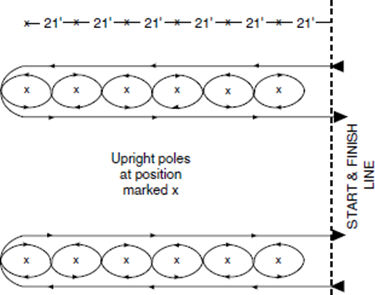
Trail:
- Unacceptable Obstacles
- Tires
- Animals (alive or dead)
- Hides
- Jumps
- Rocking, floating or moving bridges
- Flames, dry ice, fire extinguishers, etc.
- Logs or poles elevated in a manner that causes them to roll
- Mandatory Obstacles
- Ride over at least 4 logs or poles.
- Poles can be in a straight, curved or zigzag line.
- The space between poles is to be measured on the path the horse is to take:
- Ground poles for walk (not elevated)—spaced a minimum of 40-50cm (15– 20″) apart.
- Ground poles for walk (elevated)—spaced a minimum of 56cm (22″) apart and may be elevated a maximum of 30cm (12”) measured from the ground to the top of the element.
- Ground poles for trot (not elevated)—spaced a minimum of 90-107cm (3’–3’6″) apart.
- Ground poles for canter (not elevated)—spaced a minimum of 2m (6–7′) apart.
- Serpentine obstacles at a walk, trot, or canter.
- Obstacles may include:
- Orange safety cones
- Stakes 2m (6’6″) high, made of plastic, wood or other suitable, safe materials, set in a base constructed so as not to interfere with the horse’s path.
- Barrels or quarter drums
- Plants in safe tubs or planters
- Natural obstacles such as trees and bushes that are trimmed high enough so as not to be a safety hazard for the athletes
- Spacing should be a minimum of:
- 2m (6–7′) for the walk
- 3m (9–10′) for the trot
- 10m (33′) for the canter
- When designing a course for assisted riders, the course designer must remember to include adequate space for the side walkers.
- Obstacles may include:
- Carry an object from one part of the arena to another. Plastic bags and metal cans should not be used.
- Ride over at least 4 logs or poles.
- Optional Obstacles
- Ride over a wooden bridge.
- Bridge must be a minimum of 1m (36″) wide and a minimum of 1.83m (6′) long.
- Remove and replace items from a mailbox.
- Draw a circle, square, cross or another shape on a blackboard.
- Navigate a labyrinth.
- Ride into a square consisting of 4 ground poles, each a minimum of 1.55m (5′) long. The athlete will enter the square over a designated pole, execute a prescribed maneuver, and exit over a designated pole.
- Pass between two sawhorses of standard dimensions with solid ends. The sawhorses should be 1.83m (6′) apart.
- Each sawhorse should be draped with a saddle blanket.
- Stop the horse in front of, over or behind a ground pole.
- Ride through or under brush.
- Guide the horse through an L, V or Z pattern of ground poles.
- Ride into or out of a ditch without lunging or jumping.
- Negotiate any other safe obstacle which could be encountered on trail rides. (In designing these obstacles, figure the horse’s wheelbase to be 1.53m, or 5′, from front hooves to back hooves.) The approval of the judge is mandatory for these obstacles.
- Ride through a combination of two or more obstacles.
- Ride over a wooden bridge.
Prix Caprilli:
- Setup:
- The arena should be set up the same as for Dressage with the dimensions 20m X 60m
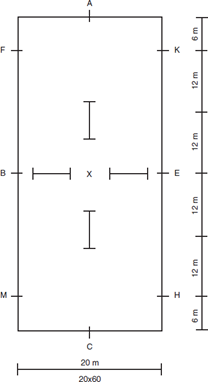
- Jump fences:
- Fences 1 and 2 should be placed on the line AXC, with their centers exactly 11m (36′) from X.
- The height of fences 1 and 2 should be set at 45cm (18″).
- Fences 3 and 4 should be placed on the line BXE, spaced 2.5m (8′) from the arena fence.
- The height of fence 3 should be set at 60cm (24″).
- Fence 4 will be an oxer set at 60 cm (24″) height, with no more than a 60cm (24″) spread.
- The top elements of all fences must rest in jump cups mounted on jump standards.
- Fences should be painted white or a neutral color and may be tastefully decorated with flowers, shrubs, etc.
- The minimum width between the jump standards is 3m (10′). The maximum width between the jump standards is 3.6m (12′).
GENERAL RULES
- A rider must use the same horse in all events during the entire competition except if a horse is sick or unsound, and it causes a safety issue.
SHOW PROCEDURE
- Cue cards may be used for hearing impaired athletes. In order for the cues to be universal, they should be designated as follows:
- 1=Walk; 2=Sitting Trot/Jog; 3=Posting Trot; 4=Canter/Lope; 0=Reverse; Universal Stop Sign=Halt
Execution of Dressage Tests
- Calling Tests
- All Special Olympics Dressage tests may be called/read.
- If a test is to be called, it is the responsibility of the coach to arrange for a person to read the test.
- Lateness in calling the movements and errors in the reading of the test will not relieve the rider from error penalties.
- Calling the test is limited to reading the movement as it is written only once. Repeating movements by the caller will constitute unauthorized assistance.
- Except for safety reasons, unauthorized assistance by the person calling the test or anyone else is prohibited and is cause for elimination.
- Gaits
- Halt – At the halt, the horse’s neck should be raised, the poll high, and the head slightly in front of the vertical. While remaining “on the bit” and maintaining a light and soft contact with the rider’s hands, the horse may quietly chomp the bit and should be ready to move off at the slightest indication of the rider.
- Walk – A regular and unconstrained walk in which the horse is energetic but calm, moving with even, determined steps, showing four distinctly marked, evenly spaced beats. The hind feet should step forward into the prints of the fore feet. The rider should maintain a light, steady contact with the horse’s mouth.
- Free Walk on Long Reins – A pace of relaxation in which the horse is allowed complete freedom to lower and stretch out his head and neck.
- Trot – This is a pace in which the horse moves in proper balance and, remaining “on the bit,” goes forward with even, elastic steps and good hock action. The expression “good hock action” does not mean that collection is required. It only underlines the importance of impulsion originating from activity of the hindquarters.
- Canter – This is a pace in which a horse moves in proper balance and, remaining “on the bit,” goes forward with even, light and cadenced strides and push from the hindquarters. This underlines the importance of impulsion originating from the activity of the hindquarters.
- Position and Aids of the Rider
- All movements should be executed without apparent effort of the rider.
- The athlete should be well balanced and the legs should be steady.
- The upper body should be easy, free and erect.
- The hands should be low and close together without, however, touching each other or the horse. The thumb will be the highest point.
- The elbows and arms should be close to the body, enabling the rider to follow the movement of the horse smoothly and freely, as well as to apply his/her aids imperceptibly.
- Riding with both hands is obligatory.
- Errors
- When an athlete makes an “error of the course” (e.g. takes the wrong turn, omits a movement, etc.) the judge warns the athlete by sounding the bell or blowing the whistle. The judge shows the athlete, if necessary, the point at which the test is to be taken up again and the next movement to be executed. The judge then leaves the athlete to continue unassisted.
- In some cases, when the athlete makes an “error of the course”, the sounding of the bell might unnecessarily impede the fluency of the performance. In these instances, it is at the judge’s discretion whether to sound the bell or not.
- In Special Olympics tests, every “error of the course,” whether the bell is sounded or not, must be penalized in the following manner:
- The first time by 1 point.
- The second time by 2 points.
- The third time by 4 points.
- The fourth time by elimination, although the athlete may continue his/her performance to the end.
Execution of Showmanship Patterns
- Special Olympics showmanship pattern for supported athletes:
- Test 1. Athlete will display their horse to the judge while all standing in a line facing the bleachers. They will use the 4-quadrant method as per SO rules.
- Test 2. Each athlete will be asked to walk their horse from 1 Cone to another across the short side of the area.
- Test 3. Each athlete will then turn their horse and walk back to the first cone.
- Test 4. Each rider will then walk their horse back to their starting place in the lineup and halt.
- Test 5. Each athlete will then back their horse up 2 steps in the line and halt.
- Special Olympics showmanship pattern for unsupported athletes:
- Test 1. Athlete will display their horse to the judge while all standing in a line facing the bleachers. They will use the 4-quadrant method as per SO rules.
- Test 2. Each athlete will be asked to walk their horse from 1 Cone to another across the short side of the arena.
- Test 3. Each athlete will then turn their horse and walk back to the first cone.
- Test 4. Each rider will then walk their horse back to their starting place in the lineup and halt.
- Test 5. Each athlete will then back their horse up 2 steps in the line and halt.
- Four-Quadrant Method: The following suggested guidelines of movement are meant to serve as an illustration of movement around the horse while showing in Showmanship classes
- Imaginary lines bisect the horse into four equal parts, as seen in the figure. (Note: The quadrants will be numbered I, II, III and IV for ease of identification).
- One line runs across the horse just behind the withers.
- The other imaginary line runs from head to tail.
- The athlete should move around the horse in the following manner:
- When the judge is in I, the handler should be in IV.
- As the judge moves to II, the handler should move to I.
- When the judge moves to III, the handler moves to IV.
- As the judge moves up the horse to IV, the handler returns once more to I.
- Imaginary lines bisect the horse into four equal parts, as seen in the figure. (Note: The quadrants will be numbered I, II, III and IV for ease of identification).
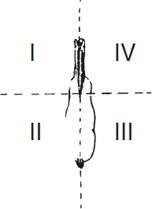
Execution of Pole Bending
A horse may start either to the right or to the left of the first pole and then run the remainder of the pattern accordingly. These instructions are written for a horse starting to the right of the first pole.
- At the signal from the starter, the athlete will:
- Run down the right side of the poles to the last pole in the line.
- Turn the last pole to the left.
- Weave the poles, passing them alternately right to left until reaching the first pole.
- Turn the first pole to the right.
- Weave the poles, passing alternately left then right until reaching the last pole.
- Turn the last pole to the left and run straight down the line of poles and cross the finish line.
Execution of Trail
Trail horses are required to work over and through obstacles.
- Required Obstacles:
- Riders in Divisions A and AP
- The course should include three elements from the list of mandatory obstacles and at least three from the optional list.
- The course should contain a minimum of six elements and a maximum of ten.
- Riders in Divisions CI, BI and IP
- The course should include three elements from the list of mandatory obstacles.
- The course should contain a minimum of five elements and a maximum of seven.
- Riders in Divisions CS, BS and SP
- The course should include two elements from the list of mandatory obstacles.
- The course should contain a minimum of four elements and a maximum of six.
- Riders in Divisions A and AP
- Mandatory Obstacles
- Ride over at least 4 logs or poles
- Poles can be in a straight, curved or zigzag line.
- The space between poles is to be measured on the path the horse is to take:
- Ground poles for walk (not elevated)—spaced a minimum of 40-50cm (15–20″) apart.
- Ground poles for walk (elevated)—spaced a minimum of 56cm (22″) apart and may be elevated a maximum of 30cm (12”) measured from the ground to the top of the element.
- Ground poles for trot (not elevated)—spaced a minimum of 90-107cm (3’–3’6″) apart.
- Ground poles for canter (not elevated)—spaced a minimum of 2m (67′) apart. 14.3.2.2
- Serpentine obstacles at a walk or trot.
- Obstacles may include:
- Orange safety cones
- Stakes 2m (6’6″) high, made of plastic, wood or other suitable, safe materials, set in a base constructed so as not to interfere with the horse’s path
- Barrels or quarter drums
- Plants in safe tubs or planters
- Natural obstacles such as trees and bushes that are trimmed high enough so as not to be a safety hazard for the athletes
- Obstacles may include:
- Spacing should be a minimum of:
- 2m (6–7′) for the walk
- 3m (9–10′) for the trot
- 10m (33′) for the canter 14.3.2.4
- When designing a course for assisted riders, the course designer must remember to include adequate space for the side walkers.
- Carry an object from one part of the arena to another. Plastic bags and metal cans should not be used.
- Ride over at least 4 logs or poles
- Optional Obstacles
- Remove and replace items from a mailbox.
- Navigate a labyrinth.
- Ride into a square consisting of 4 ground poles, each a minimum of 1.55m (5′) long. The athlete will enter the square over a designated pole, execute a prescribed maneuver, and exit over a designated pole.
- Pass between two sawhorses of standard dimnsions with solid ends. The sawhorses should be 1.83m (6′) apart. Each sawhorse should be draped with a saddle blanket.
- Stop the horse in front of, over or behind a ground pole.
- Ride through or under brush.
- Guide the horse through an L, V or Z pattern of ground poles.
- Ride into or out of a ditch without lunging or jumping.
- Negotiate any other safe obstacle which could be encountered on trail rides. (In designing these obstacles, figure the horse’s wheelbase to be 1.53m, or 5′, from front hooves to back hooves.) The approval of the judge is mandatory for these obstacles.
- Ride through a combination of two or more obstacles
Execution of Prix Caprilli
- Each movement in the test is awarded 0–10 points as in a Dressage test.
- Jumping penalties:
- Knocking down obstacle 2 faults
- First refusal (run out) 3 faults
- Second refusal 3 faults
- Third refusal elimination, although the athlete may continue his/her performance to the end.
- Errors of Course:
- First error 1 penalty point
- Second error 2 penalty points
- Third error 4 penalty points
- Fourth error elimination, although the athlete may continue his/her performance to the end.
- Use of voice 2 penalty points
- On the judges’ sheet, the marks allotted for each movement are tabulated as in Dressage and penalty points are deducted from the total.
- Tests
- The test may be called/read to the athlete. See rules for calling tests in the Dressage section.
- The walk will be performed working and the trot will be performed rising, unless otherwise stated.
JUDGING
- The following points (where appropriate) have equal consideration in judging all classes:
- Rider’s balance
- Rider’s seat
- Use of aids
- Ability to follow directions
- Ring etiquette and safety
- Sportsmanlike conduct
- Results as shown by the performance of the horse are not to be considered more important than the method used in obtaining them.
- Unauthorized assistance from horse handlers and side walkers will result in penalties.
- Side walkers may not give verbal commands or extra physical prompting, except in case of emergency.
- Special consideration will be given to riders with visual or auditory impairments or severe physical disability.
- Coaches may not act as horse handlers, side walkers or spotters for their own athlete anytime while that athlete is being judged.
Disqualification
- Outside assistance (rail side coaching) will be penalized at the judge’s discretion.
- Electronic communication devices used for the purpose of communicating between riders and individuals outside the ring are prohibited.
